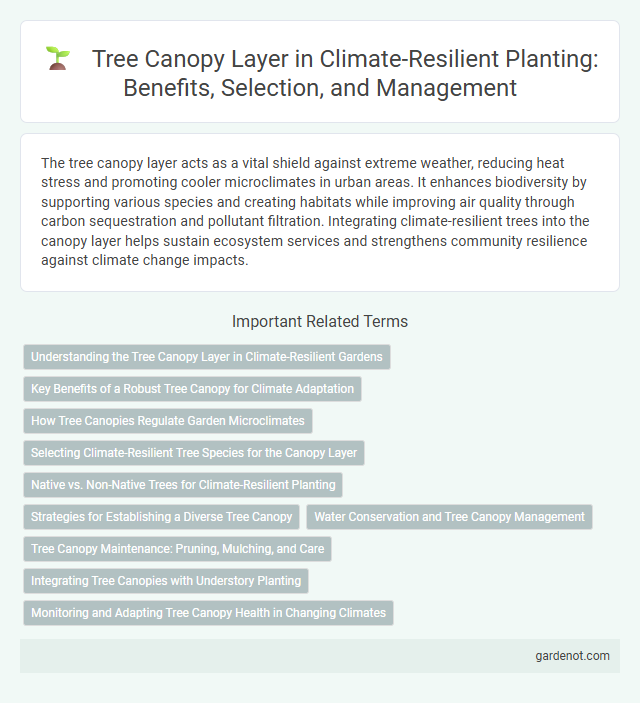The tree canopy layer acts as a vital shield against extreme weather, reducing heat stress and promoting cooler microclimates in urban areas. It enhances biodiversity by supporting various species and creating habitats while improving air quality through carbon sequestration and pollutant filtration. Integrating climate-resilient trees into the canopy layer helps sustain ecosystem services and strengthens community resilience against climate change impacts.
Understanding the Tree Canopy Layer in Climate-Resilient Gardens
The tree canopy layer plays a crucial role in climate-resilient gardens by providing shade, reducing soil erosion, and moderating temperature extremes. Mature trees with dense canopies enhance carbon sequestration and support biodiversity by creating microhabitats for various species. Effective management of the tree canopy layer helps optimize water retention and promotes overall garden resilience to climate variability.
Key Benefits of a Robust Tree Canopy for Climate Adaptation
A robust tree canopy significantly enhances urban climate adaptation by providing essential shade that reduces surface temperatures and mitigates the urban heat island effect. It improves air quality through carbon sequestration and pollutant filtration, while simultaneously enhancing stormwater management by intercepting rainfall, reducing runoff and soil erosion. This multi-layered environmental benefit supports biodiversity, promotes energy savings, and strengthens overall ecosystem resilience against climate variability.
How Tree Canopies Regulate Garden Microclimates
Tree canopies play a crucial role in regulating garden microclimates by providing shade that reduces soil temperature and moisture evaporation, creating cooler and more humid conditions beneath. The dense foliage intercepts solar radiation, which minimizes heat stress on understory plants and reduces energy consumption for nearby buildings. In urban and suburban gardens, tree canopy layers also act as windbreaks, moderating airflow and protecting delicate plants from extreme weather fluctuations.
Selecting Climate-Resilient Tree Species for the Canopy Layer
Selecting climate-resilient tree species for the canopy layer involves prioritizing species with high drought tolerance, pest resistance, and adaptability to temperature fluctuations. Native and well-adapted species like Quercus (oak) and Gleditsia triacanthos (honey locust) improve long-term canopy stability and biodiversity. Incorporating diverse species ensures ecosystem resilience, maintains carbon sequestration, and mitigates urban heat island effects effectively.
Native vs. Non-Native Trees for Climate-Resilient Planting
Native trees enhance climate resilience by supporting local biodiversity, adapting to regional soil and weather patterns, and requiring fewer resources for maintenance. Non-native trees may offer faster growth or specific shading benefits but often lack the ecological compatibility necessary for sustainable, long-term canopy health. Prioritizing native species in the tree canopy layer promotes ecosystem stability and improves resistance to climate stressors such as drought and pests.
Strategies for Establishing a Diverse Tree Canopy
Establishing a diverse tree canopy involves selecting a variety of native and climate-resilient species to enhance ecosystem stability and reduce vulnerability to pests and diseases. Implementing stratified planting techniques promotes vertical diversity, improving microclimate regulation and habitat complexity. Integrating community engagement and long-term monitoring ensures adaptive management and resilience against climate variability.
Water Conservation and Tree Canopy Management
Tree canopy management enhances water conservation by reducing soil evaporation and increasing rainfall interception, leading to improved moisture retention. Dense tree canopies create shaded microenvironments that lower ground temperatures, decreasing water demand for surrounding vegetation. Optimizing canopy density and structure through strategic planting supports sustainable water cycles and strengthens climate resilience.
Tree Canopy Maintenance: Pruning, Mulching, and Care
Proper tree canopy maintenance, including regular pruning, mulching, and care, enhances climate resilience by promoting healthy growth and maximizing shade coverage. Pruning removes dead or diseased branches, improving air circulation and reducing storm damage risks, while mulching conserves soil moisture and regulates temperature. Consistent care supports tree vitality, fostering a robust canopy that mitigates urban heat islands and improves air quality.
Integrating Tree Canopies with Understory Planting
Integrating tree canopies with understory planting enhances climate resilience by creating multi-layered vegetation that improves microclimate regulation, soil moisture retention, and biodiversity support. Tree canopies provide essential shade, reducing temperature extremes and protecting understory plants, which in turn contribute to nutrient cycling and habitat complexity. This layered planting approach strengthens ecosystem stability and fosters greater adaptation to climate stressors.
Monitoring and Adapting Tree Canopy Health in Changing Climates
Regular monitoring of tree canopy health using remote sensing and ground-based assessments enables early detection of stress factors such as drought, pests, and diseases in changing climates. Adaptive management strategies, including selective pruning, species diversification, and soil moisture enhancement, improve resilience and sustain ecosystem services. Data-driven interventions support maintaining optimal canopy density, promoting urban cooling, carbon sequestration, and biodiversity conservation under climate variability.
Tree canopy layer Infographic

 gardenot.com
gardenot.com